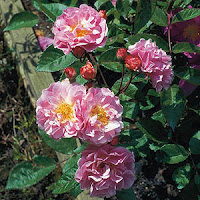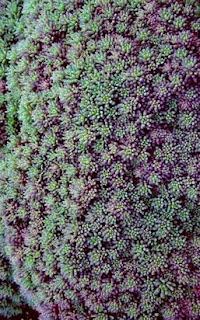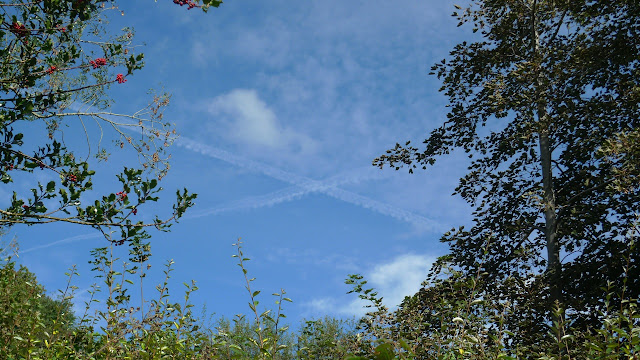The heavy rain is keeping me indoors at the moment, so a good time to catch up with my blog. This must be the wettest year I've ever experienced, which means progress in the garden is slower than usual. I'm glad I trimmed my neighbours hedge (my side) in the front yesterday while the sun was out, but managed to fill up all of the councils recycling bags in the process so they are clogging up my front garden. They only collected four of them last week, which was half of what I put out. Not sure why I can't use my neighbours' quota as most of the road didn't leave out any garden rubbish for recycling that week. It was a pleasure to use my new Bosch cordless hedge cutter for the first time, which came with 2 re-chargeable batteries. It was light and easy to grip and nowhere near as noisy as I expected. I used my new Abro stepladder for the first time too, which was essential in getting to the top of the hedge which had been neglected for so long and standing on a chair was inadequate. I have no head for heights but it felt safer than the ladder that was left here by the previous owners.
On a dry day I took a photo of my white passionflowers which are currently blooming in the front garden, whereas the purple ones in the back garden are not. The latter have produced more leaf and have managed to climb the trellis at least this year, whereas the ones I only planted recently are doing fine. I think it is because they are in containers and so have better soil and drainage, as well as more light although not in full sun for the whole day due to my neighbours hedge.
 |
| Passionflowers in front garden tub |
I've been enjoying creating my gravel garden out the back on level one and will be tweaking it throughout the year. I want to keep it fairly minimalist as a low maintenance bed so have not planted it profusely, as well as needing to test how certain plants thrive or not before buying more than one or two at a time. The cotton lavender has died already, but they didn't look too strong when they were delivered. I've moved some plants from less sunny areas of the garden to the gravel garden which gets full sun much of the time as it faces south, and bought a few new ones to provide different structural interest. So far, this is what is planted there:
 |
| SHASTA DAISY 'PHYLISS SMITH' |
1. Shasta daisy - the shaggy one called LEUCANTHEMUM X SUPERBUM PHYLLIS SMITH
2. Echinacea purpurea - Had tried to grow these from seed, but the small plants didn't survive long so bought a mature one from the market.
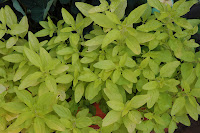 |
| GOLDEN OREGANO |
3. Golden oregano - ORIGANUM VULGARE AUREUM
4. Lavender hidcote - moved from elsewhere in the garden.
5. Lavender munstead moved from a shadier bed. Larger than the hidcote variety, it is planted next to the echinacea and shasta daisy to form a group with some height away from the rockery.
6. Varigated hebe - no exact name when bought at the market. One has more cream and silver, and the other is cream and mauve. They form a front border of dwarf shrubs with the lavender hidcote.
7. Hebe rakaiensis looked too similar to my Hebe emerald green already in my gravel bed, so I planted this in another raised bed and instead put the Hebe Champagne in the front border instead.
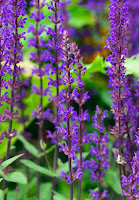 |
| SALVIA NEMOROSA CARADONNA |
8. Salvia nemorosa ‘Caradonna’. It has glowing, purple-black stems and deep violet-purple flowers that bloom from June to October. I thought it would look good near the lavender munstead.
I also planted blue lobelia and mauve aubretia to trail over the edge of the raised bed wall, which I've copied at the top of the retaining wall to cascade down and soften the hard edges a bit.
I still need to find some small creamy yellow/lemon flowers to provide contrast with all the lavender,blues and purple.
Some plants that form cushions, like the mossy saxifrages but tolerant of more direct sun, is also on my wish list although not urgent.
In the small rockery I have saxifrage elf rose, dianthus, St.John's wort (taken from the front garden tub), Festuca glauca (short blue grass mound), and what little was left of the Irish moss which I had grown from seed.
There is also a creeping phlox and a small white daisy type plant which I bought for 20p each in a local shop. I will add the names once I have checked the tags again.
 |
| CORDYLINE AUSTRALIS RED STAR |
In a pot on the gravel bed I have put my Cordyline australis red star plant so I can take it in during the winter. It has lived in my utility room for a couple of years and the leaves are now turning a dullish brown instead of plum red, so it doesn't seem to like it too much out there. Maybe too much rain for it at the moment.
The rosemary that was in a pot has now been planted directly into the gravel garden. There are probably more plants but that's all I can recall right now.
I forgot all about laying down weed suppressing fabric until someone mentioned it to me during a phone conversation. I don't think it will make much difference as the weed seeds will blow on to the surface from my neighbours adjoining raised bed, which hasn't been touched in the two years I've been living here.
There will be photos of the progress I've made so far with my gravel garden and rockery once the rain stops. I had ordered two 25kg bags of fine 10mm gravel and two 25 kg bags of clean aggregate chippings for the raised bed, which is about 6ft by 4ft. I could have done with 3 bags of the fine and one bag of the 20mm, but will empty the larger gravel on the pathway up the side of the back garden, prior to putting down something more permanent there, as it will make a good base. The fine gravel is quite useful for a lot of things including helping to keep slugs and snails off the plants as it is sharp and angular.
Also, when you plant something new in the gravel garden it disturbs the top dressing, so more gravel needs to be applied. It was only enough for a thin coating, and the larger gravel was mainly to deter the cats next door from thinking it is was large litter tray.
So in total the gravel only cost me £15.00 inc VAT and free local delivery.
I also used some Perlite to aid drainage as the soil is clay, and scattered some lime over the bed too as I read somewhere that lavender needs lime. Over time I'll keep adding more fine gravel as it works its way down into the soil.
The man who re-built my stone retaining wall had chucked a load of soil and rubble on the slope bordering my other neighbour (to the east) who also does no gardening. I hope he didn't get rid of the topsoil from the bed, but even so I still have to now shovel it all out of the way because I can't weed that area prior to planting my new hedge. I don't know why he didn't ask first because it has made more work for me, and that slope is difficult to climb now it is higher. He also left my potted palm on level two, which was really heavy to struggle with down the steps. One of the steps has now broken fully apart but I've decided to tackle the job of the steps myself. Well he did tell me that if I wanted to use mortar I'd have to do it myself, and I've not heard from him since. If it ever stops raining I would really like to get on with the hard landscaping. It is something I've never done before and am feeling a bit more confidant about it after reading some of my gardening books. If I don't practice then I'm never going to learn new skills.




